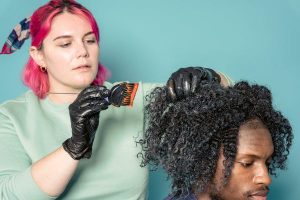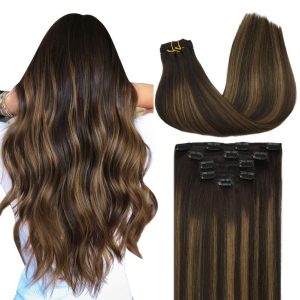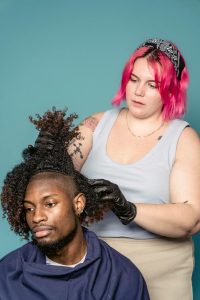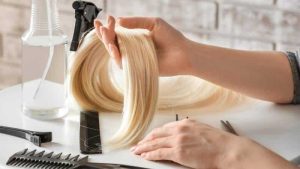Hair extensions are a great way to add length, volume, or a pop of color to your hair. But what if the color of your extensions isn’t quite right? Can you dye them? The answer depends on the type of hair extensions you have.
All About Hair Extensions
There are two main types of hair extensions: synthetic and human hair.
Synthetic hair extensions are typically more affordable than human hair extensions. They come in a wide variety of colors and styles. However, they cannot be dyed.
Human hair extensions are more expensive than synthetic extensions, but they can be styled and colored just like your own hair. This gives you more flexibility to achieve the look you want.
Dyeing Human Hair Extensions
If you have human hair extensions, you can dye them at home or take them to a professional stylist.
Here are some things to keep in mind if you’re planning to dye your extensions at home:
Test the dye on a small strand of hair first.
This will help you see how the color will take and avoid any surprises.
Use a semi-permanent or demi-permanent dye.
These types of dyes are gentler on hair than permanent dyes.
Be careful not to get dye on the bonds or wefts of the extensions.
This can damage the extensions and make them difficult to remove.
Condition your extensions after dyeing them.
Dyeing can dry out hair, so it’s important to replenish moisture.
Here are the benefits of getting your extensions dyed by a professional stylist:
- A stylist can help you choose the right color for your extensions.
- A stylist can ensure that the dye is applied evenly and that the extensions are not damaged.
- A stylist can tone the extensions to achieve a more natural look.
Lightening vs. Darkening Hair Extensions
Can you lighten human hair extensions? It’s generally not recommended to lighten hair extensions at home. Bleach can be very damaging to hair, and it can cause the extensions to break or become matted. If you want to lighten your extensions, it’s best to take them to a professional stylist.
However, you can usually darken human hair extensions without too much trouble. Just follow the same tips for dyeing extensions at home.
Caring for Dyed Hair Extensions
Once you’ve dyed your hair extensions, it’s important to take care of them properly. Here are a few tips:
- Use a sulfate-free shampoo and conditioner. Sulfates can strip color from hair.
- Avoid heat styling as much as possible. Heat can damage dyed hair.
- Get regular trims. Split ends can travel up the hair shaft and make your extensions look frizzy.
With proper care, your dyed hair extensions can last for many months.
Choosing the Right Hair Extensions for Dyeing
Since only human hair extensions can be dyed, choosing the right type is crucial. Here’s a breakdown of different human hair extensions and their dyeing suitability:
-
Remy human hair extensions: These are considered the top tier of human hair extensions. Remy hair retains its natural hair cuticle, making it the most durable and accepting of dye.
-
Virgin human hair extensions: These extensions have never been chemically treated, meaning they can be dyed to a wider range of colors. However, virgin hair can be slightly more expensive.
-
Non-Remy human hair extensions: These extensions are generally more affordable but may have undergone some chemical processing. While dyeing is possible, consult a professional to avoid unexpected color results.
Safety Precautions for Dyeing Hair Extensions at Home
If you decide to dye your extensions at home, prioritize safety:
- Well-ventilated area: Open windows or use a fan to avoid inhaling harsh chemicals.
- Gloves: Wear disposable gloves to protect your hands from dye stains and irritation.
- Patch test: Before applying dye to the entire extension, do a small strand test to check for allergic reactions or unexpected color results.
Helpful Tools for Dyeing Hair Extensions at Home
Having the right tools can make the dyeing process smoother:
- Non-metallic mixing bowl and applicator brush: Metal can react with the dye, altering the color.
- Plastic clips or hair ties: To section the hair extensions for controlled application.
- Clear plastic wrap: To create a warm environment for processing the dye (optional).
By following these tips and understanding the different hair extension types, you can determine if dyeing your extensions is the right choice for you. Remember, consulting a professional stylist is always an option, especially for complex coloring techniques.
Exploring Alternatives to Dyeing Extensions
While dyeing human hair extensions offers more customization, there are other ways to achieve your desired look:
-
Colored extensions: Many companies sell pre-colored human hair extensions in a wide variety of colors. This eliminates the risk of damaging your extensions through dyeing.
-
Temporary hair color: Consider temporary hair color options like colored hairspray or mascara. These can add a touch of color without a permanent commitment.
-
Hair accessories: Fun hair accessories like ribbons or clips with pops of color can add personality to your hairstyle without altering the extensions themselves.
Maintaining the Vibrancy of Your Hair Extensions
Whether your extensions are dyed or natural colored, proper care helps them last longer and look their best:
-
Wash gently: Use cool water and a sulfate-free shampoo and conditioner designed for extensions.
-
Deep condition regularly: Deep conditioning helps keep extensions hydrated and manageable.
-
Minimize heat styling: Heat can damage hair extensions. If heat styling is necessary, use a heat protectant spray and lower heat settings.
-
Store carefully: When not in use, store your extensions in a cool, dry place. Loose braiding or a ponytail can help prevent tangles.
By following these tips, you can extend the lifespan of your hair extensions and enjoy your hairstyle for longer.
Adding Dimension with Highlights or Lowlights
While dyeing your entire extensions can be a bold choice, consider adding dimension with highlights or lowlights for a more natural look. This can also be a way to subtly change the overall color of your extensions without a drastic transformation.
Here are some things to keep in mind:
- Highlighting for dimension: Adding lighter highlights can add brightness and texture to your hair.
- Lowlights for depth: Lowlights add darker tones, creating depth and richness, especially for extensions that appear very blonde or light.
If you’re unsure about highlighting or lowlighting at home, consult a professional stylist. They can advise on the best placement and color tones to achieve your desired look.





